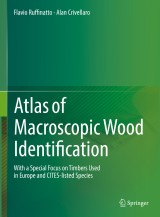Details

Atlas of Macroscopic Wood Identification
With a Special Focus on Timbers Used in Europe and CITES-listed Species|
CHF 258.50 |
|
| Verlag: | Springer |
| Format: | |
| Veröffentl.: | 12.12.2019 |
| ISBN/EAN: | 9783030235666 |
| Sprache: | englisch |
Dieses eBook enthält ein Wasserzeichen.
Beschreibungen
<p>This atlas presents macroscopic descriptions, macro cross section pictures, general characteristics and identification keys of 335 wood species currently introduced in the European timber market from all over the world. Overall 292 different genera are represented and CITES-listed timbers are also included. Macroscopic descriptions are based on a recently proposed list of macroscopic features for wood identification. Macroscopic features and their codes are defined and illustrated in the atlas. Wood descriptions also include information about natural durability, physical and mechanical properties, end uses, environmental sustainability and possible related misleading commercial names. Furthermore, each genus is described in terms of number of species, geographical distribution and main commercial timbers, and details are given about to what extent timbers within the genus can be typically identified through macroscopic and microscopic analysis, if any.</p><p>The atlas will be a valuable guide for all agents in charge for timber verification, those involved in the European Timber Regulation enforcement and CITES inspections, as well as wood scientists, foresters, wood sellers, wood restorers, and any wood worker and wood passionate interested in a fast and reliable tool for wood identification.</p>
Introduction.- Background of the study, aims and scope.- Wood structure and plans of observations.- Brief introduction on wood structure and plans of observation for macroscopic identification.- Samples preparation and observation.- Instructions on how to prepare samples and observe them.- Materials and methods.- Origin of the material studied, samples preparation and photos acquisition.- Definition of Macroscopic Features.- List of macroscopic features with definitions and illustrations.- Identification key.- Wood descriptions.- References.- Index of species.
<p><b>Flavio Ruffinatto</b> has a MS in Forestry and Environmental Sciences and a PhD in Agricultural, Forestry and Food Sciences (University of Turin, Italy). His professional and research interests include macroscopic and microscopic wood identification, forensic timber identification, wooden cultural heritage diagnostics and conservation. He has extensive experience teaching wood technology and wood identification for academic students and vocational training bodies.<br></p><b>Alan Crivellaro</b> obtained his degree in Wood Science and Technology (2002), a B.Sc. in Forestry (2008) and a PhD (Doctor Europaeus) in Ecology in 2012 at the University of Padova (Italy). In 2002 he joined as assistant researcher the Trees and Timber Institute of the Italian National Research Council, and since that time he has been involved in a research program on timber strength classification until 2007 when he focused on his PhD. From 2015 to 2018 he was assistant professor in Wood Science at the Dept. Land, Environment, Agriculture and Forestry at the University of Padova. Alan Crivellaro teaches wood anatomy and plant ecology at international fieldweeks and summer school.<br>
<p>This atlas presents macroscopic descriptions, macro cross section pictures, general characteristics and identification keys of 335 wood species currently introduced in the European timber market from all over the world. Overall 292 different genera are represented and CITES-listed timbers are also included. Macroscopic descriptions are based on a recently proposed list of macroscopic features for wood identification. Macroscopic features and their codes are defined and illustrated in the atlas. Wood descriptions also include information about natural durability, physical and mechanical properties, end uses, environmental sustainability and possible related misleading commercial names. Furthermore, each genus is described in terms of number of species, geographical distribution and main commercial timbers, and details are given about to what extent timbers within the genus can be typically identified through macroscopic and microscopic analysis, if any.</p><p>The atlas will be a valuable guide for all agents in charge for timber verification, those involved in the European Timber Regulation enforcement and CITES inspections, as well as wood scientists, foresters, wood sellers, wood restorers, and any wood worker and wood passionate interested in a fast and reliable tool for wood identification.</p>
<p>Includes all the main woods used in Europe and many lesser-known timbers</p><p>Not only macroscopic descriptions, but lots of other information about each wood</p><p>Describes to what extent timbers within one genus can be identified through macroscopic and microscopic analysis</p>
Diese Produkte könnten Sie auch interessieren:

Agricultural Biodiversity and Biotechnology in Economic Development

von: Joseph Cooper, Leslie Lipper, David Zilberman

CHF 236.00

Policy Reforms and Agriculture Development in Central Asia

von: Sandjar Djalalov, Suresh Chandra Babu

CHF 236.00

Regulating Agricultural Biotechnology

von: Richard E. Just, Julian M. Alston, David Zilberman

CHF 236.00













